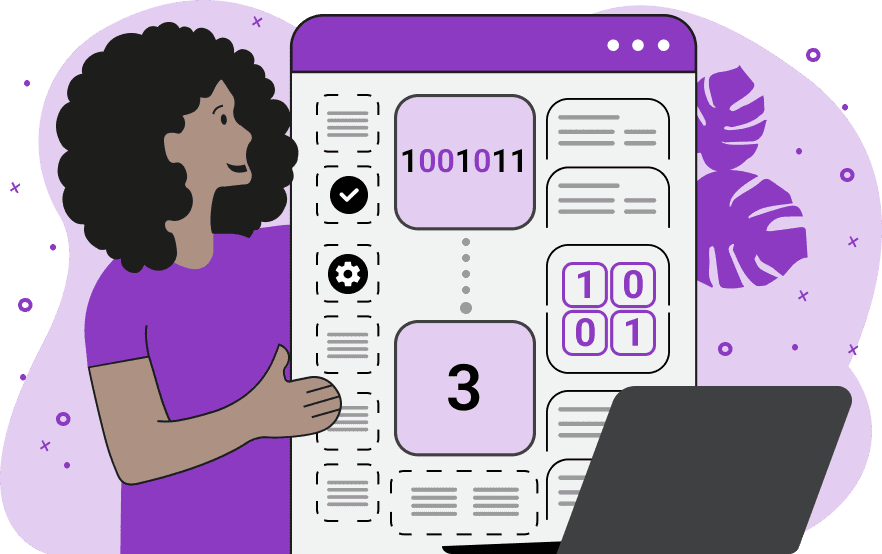Free online binary zeros counter. Just load your binary values and the number of unset bits will be automatically calculated. There are no ads, popups, or nonsense, just an awesome low bit counter. Load binary values – get the number of zeros. Created for developers by developers from team Browserling.
Free online binary zeros counter. Just load your binary values and the number of unset bits will be automatically calculated. There are no ads, popups, or nonsense, just an awesome low bit counter. Load binary values – get the number of zeros. Created for developers by developers from team Browserling.

This utility counts the number of zeros in binary numbers. By default, it operates in multi-line mode, which allows you to enter binary numbers on each line and get the result for each value. If you want to get the total number of low bits in all numbers, simply turn off the multi-line option. The input binary values can contain any number of bits and they can also have base-2 prefixes "b", "B", "0b", "0B" or base-2 suffixes "b", "B", "₂". Simple and easy!
This utility counts the number of zeros in binary numbers. By default, it operates in multi-line mode, which allows you to enter binary numbers on each line and get the result for each value. If you want to get the total number of low bits in all numbers, simply turn off the multi-line option. The input binary values can contain any number of bits and they can also have base-2 prefixes "b", "B", "0b", "0B" or base-2 suffixes "b", "B", "₂". Simple and easy!
In this example, we count the number of zeros of three binary values. Since the multi-line option is enabled, the number of unset bits in each number is printed next to it in the output.
In this example, we have loaded six binaries in the input and turned off the multi-line option. As a result, the output displays the total number of low bits in all numbers. The symbols '0' that is used in binary prefixes '0b' and '0B' is not counted in the total amount.
In this example, the binary representation of the input number contains 512 characters. Our algorithm is instantly able to tell how many zero bits there are and it turns out there are 267 zero bits in this number.
You can pass input to this tool via ?input query argument and it will automatically compute output. Here's how to type it in your browser's address bar. Click to try!
View and edit binary values in your browser.
Convert binary numbers to a binary file.
Create a binary dump of files in your browser.
Convert binary numbers to ternary numbers.
Convert ternary numbers to binary numbers.
Convert binary values to any base (up to base 64).
Convert binary numbers to Roman numerals.
Convert Roman numerals to binary values.
Find the sum of set bits in binary numbers.
Swap pairs of adjacent bits in a binary number.
Create a list of increasing of decreasing binary numbers.
Create a binary number with alternating bits.
Create a list of all binary choices of a specific length.
Calculate bitwise sheffer stroke operator of binary values.
Encode every binary bit as a binary coded decimal.
Decode binary coded decimals to binary bits.
Perform division operation on several binary numbers.
Rotate bits of a binary number to the right.
Rotate bits of a binary number to the left.
Extract n-th bit from a binary number.
Count parity of a binary number.
Convert EBCDIC characters to binary values.
Convert binary bits to EBCDIC symbols.
Change endianness of a binary number.
Convert a binary number from little endian to big endian.
Convert a binary number from big endian to little endian.
Find the binary representation of a floating point number.
Decode a binary number to a floating point number.
Convert any image to binary colors.
Convert a binary string to a bitmap image.
Convert a bitmap image to zeros and ones.
Replace each bit with two bits in each byte.
Group bits together to create bytes.
Expand bytes into individual bits.
Split a binary number into smaller binary numbers.
Join multiple smaller binary numbers into a single binary.
Extract a part of a binary number.
Substitute ones and zeros with any other values.
Add signed or unsigned padding to binary numbers.
Drop leading or trailing bits and make a binary value shorter.
Introduce random errors in binary values.
Print the same binary numbers in the same colors.
Use two different colors for binary zeros and ones.
See the difference between two binary blobs of bytes.
Create visualizations of and, or, xor, not binary ops.
Make binary bits go in a zigzag.
Make binary bits go in a spiral.
Make binary bits go in a circle.
Create a sqaure shape from binary bits.
Create a sequence of random binary bits.
Create a sequence of random binary nybbles.
Create a sequence of random binary octets.
Create a sequence of random binary words.
Create a sequence of random binary long words.
Create a look-and-say sequence in base-2.
Apply run length encoding algorithm on a binary sequence.
Decode a previously RLE-encoded binary sequence.
Spell a binary number in words.
Print statistics of the input binary values.
Subscribe to our updates. We'll let you know when we release new tools, features, and organize online workshops.
Enter your email here
We're Browserling — a friendly and fun cross-browser testing company powered by alien technology. At Browserling we love to make people's lives easier, so we created this collection of binary tools. Our tools have the simplest user interface that doesn't require advanced computer skills and they are used by millions of people every month. Our binary tools are actually powered by our programmer tools that we created over the last couple of years. Check them out!

